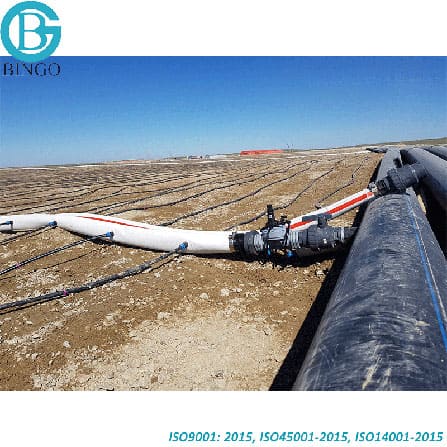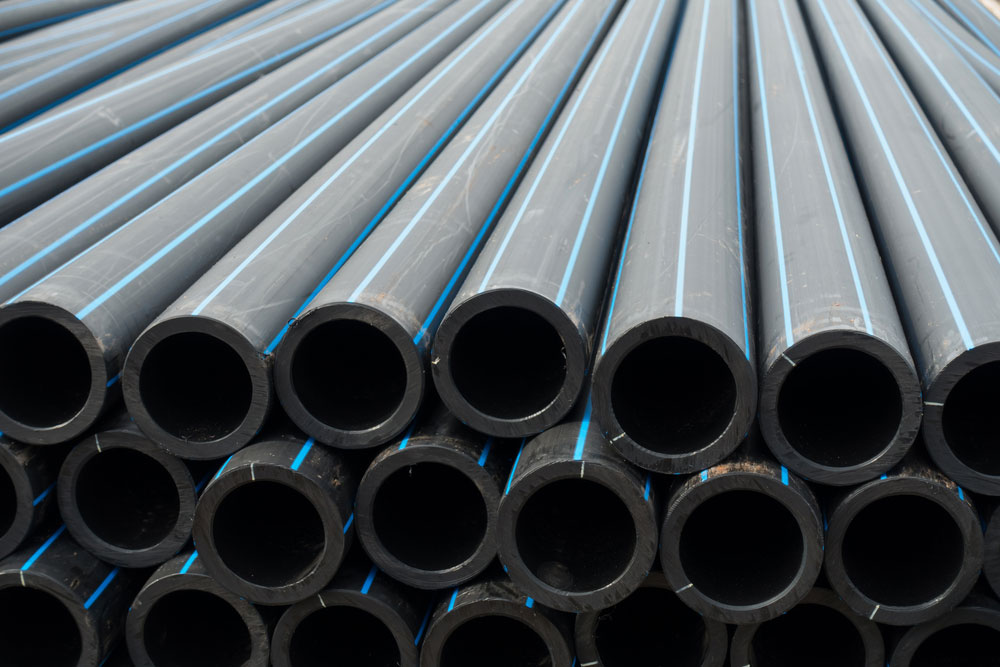Check Out the Production Process Behind High-Quality HDPE Pipe and Its Applications
The manufacturing process of premium HDPE pipelines is intricate and systematic. It begins with the choice of raw products that improve performance. Following this, ethylene undergoes polymerization to develop material, which is then formed with extrusion. Quality control is critical, guaranteeing that the last item satisfies stringent requirements. Nevertheless, the trip of HDPE pipelines doesn't end with production. Their applications throughout different industries reveal a wider importance worth analyzing.
Understanding HDPE: Features and Advantages

High-density polyethylene (HDPE) is a functional thermoplastic known for its resilience and resistance to numerous environmental factors. This material exhibits superb tensile toughness, making it appropriate for requiring applications. Its low-density framework adds to a light-weight product, assisting in ease of managing and setup. HDPE also showcases impressive resistance to chemicals, which reduces destruction when subjected to harsh materials.
The material's reduced moisture absorption better enhances its longevity, making it suitable for usage in pipelines and tank. Additionally, HDPE is immune to ultraviolet (UV) radiation, ensuring that products preserve their integrity even when subjected to sunshine. Its adaptability allows for the development of complex shapes without endangering toughness. The green nature of HDPE, commonly originated from recycled products, includes in its allure, promoting lasting practices in production. Generally, these residential or commercial properties and advantages make HDPE a favored selection for numerous industrial and consumer applications.
Basic Material Selection for HDPE Manufacturing
The selection of resources for HDPE manufacturing is important to verify the last item fulfills the preferred requirements and top quality criteria. High-density polyethylene (HDPE) is largely generated from polymerized ethylene, stemmed from nonrenewable fuel sources such as natural gas or crude oil. The top quality of these feedstocks significantly affects the mechanical and thermal residential properties of the last HDPE.
Ingredients also play a significant role in boosting HDPE's efficiency, including antioxidants, UV stabilizers, and colorants, which enhance sturdiness and resistance to ecological aspects. The selection procedure must think about not only the chemical composition of the raw products however also their processing qualities to guarantee reliable manufacturing.
The sourcing of raw materials need to focus on sustainability and conformity with environmental laws, as responsible techniques are crucial in today's market. Ultimately, cautious raw product choice lays the structure for producing high-grade HDPE pipelines appropriate for varied applications.
The Extrusion Process: Shaping HDPE Pipeline
The extrusion procedure plays an essential role in forming HDPE pipelines, starting with meticulous material prep work techniques that guarantee perfect circulation and uniformity. Just as essential is the layout of the die, which straight affects the last dimensions and surface high quality of the pipeline. Together, these factors contribute greatly to the efficiency and quality of HDPE pipe production.
Material Preparation Strategies
Effective manufacturing of HDPE pipelines begins with precise product preparation methods, especially the extrusion procedure. During this stage, high-density polyethylene resin is very first dried to get rid of dampness, guaranteeing excellent circulation qualities. The resin is then fed into the extruder, where it goes through heating and melting, changing into a viscous state. This heating procedure is carefully controlled to maintain the product's integrity and efficiency. The molten HDPE is required with a die, shaping it into a constant pipeline type. Appropriate temperature monitoring throughout extrusion is essential, as it straight impacts the material's properties and the end product quality. When shaped, the HDPE pipeline is cooled down and cut to defined sizes, ready for subsequent processing and applications.
Die Style Value
Accuracy in die design plays a necessary role in the extrusion procedure of HDPE pipelines. The die acts as the last shaping device, directly affecting the pipe's dimensions, wall surface density, and surface area coating. A well-designed die guarantees consistent product flow, minimizing flaws such as abnormalities and weak areas. The geometry of the die must be maximized to fit the specific buildings of HDPE, including its viscosity and thermal habits throughout extrusion. Additionally, the cooling rate of the product as it goes through the die can noticeably impact the pipe's architectural honesty. Subsequently, purchasing sophisticated die innovation is essential for suppliers intending to generate top notch HDPE pipelines that meet market criteria and client assumptions.
Quality Assurance Measures in HDPE Production
Numerous variables influence the quality of HDPE pipeline manufacturing, reliable high quality control measures are essential to ensure uniformity and integrity in the final item (hdpe pipe in stock Midland TX). Key quality assurance practices include rigorous product assessment, validating that the raw polyethylene fulfills well established requirements for pureness and thickness. Throughout the extrusion process, parameters such as temperature level, stress, and cooling time are very closely checked to preserve dimensional accuracy and structural stability
In addition, post-production screening is essential; suppliers frequently conduct hydrostatic examinations to examine the pipe's strength and resistance to stress. Aesthetic assessments for surface problems further boost quality control. Accreditation from appropriate criteria organizations, like ASTM or ISO, gives an extra layer of integrity. By carrying out these comprehensive quality assurance steps, producers can minimize flaws, boost performance, and make sure that the HDPE pipelines meet the certain requirements of different applications, ultimately bring about customer fulfillment and count on the product.
Applications of HDPE Pipeline Throughout Industries
HDPE pipes are made use of throughout numerous fields as a result of their resilience and flexibility. In water distribution systems, they assure reliable delivery, while in wastewater monitoring, they supply trusted solutions for waste transport. Additionally, agricultural irrigation networks take advantage of HDPE's resistance to deterioration and adaptability, making it an excellent choice for modern farming practices.

Water Distribution Solutions
A substantial number of markets count on high-density polyethylene (HDPE) pipes for effective water distribution systems. Understood for their durability and resistance to corrosion, HDPE pipelines are commonly made use of in community water networks, farming irrigation, and industrial applications. Their light-weight nature facilitates easy handling and setup, lowering labor costs and time. Furthermore, HDPE pipelines can fit various pressure degrees, making them suitable for both reduced and high-pressure systems. American Plastics HDPE Pipe for Oilfield. The adaptability of the product enables seamless assimilation right into existing facilities, lessening the need for considerable excavation. HDPE's resistance to chemical leaching warranties that the water delivered continues to be secure and clean, making it an excellent choice for preserving the high quality of potable water across different fields.
Wastewater Management Solutions
Reliable water distribution systems likewise lead the way for innovative wastewater management options, where high-density polyethylene (HDPE) pipelines play a significant role. Prominent for their longevity and resistance to corrosion, HDPE pipes are optimal for transferring wastewater in numerous settings. Their flexibility permits simple setup in complicated atmospheres, reducing the demand for considerable excavation. Furthermore, HDPE's smooth indoor surface minimizes friction, enhancing flow rates and efficiency. These pipes are additionally immune to chemical leaching, ensuring that contaminants do not jeopardize the surrounding atmosphere. Industries, communities, and treatment facilities increasingly rely upon HDPE pipelines for their dependability and durability, making them a favored option for modern wastewater monitoring systems. This flexibility underscores the important relevance of HDPE pipelines across many applications.
Agricultural Watering Networks
Agricultural irrigation networks benefit greatly from using high-density polyethylene (HDPE) pipelines, which provide reliable and reliable water distribution to crops. HDPE pipelines are light-weight, making them simple to move and set up, while their flexibility permits numerous configurations in varied surfaces. These pipes show exceptional resistance to deterioration, chemicals, and UV radiation, ensuring durability in extreme farming settings. Additionally, their smooth interior surface area minimizes friction loss, maximizing water circulation and reducing power costs related to pumping. The longevity of HDPE pipelines, typically exceeding half a century, adds to decrease upkeep and replacement expenses. Consequently, farmers increasingly depend on HDPE pipes to enhance irrigation effectiveness and promote lasting agricultural methods, ultimately leading to boosted crop returns and resource conservation.
Future Patterns in HDPE Pipe Innovation
As the demand for sustainable and reliable infrastructure expands, developments in HDPE pipeline modern technology are positioned to change different markets. Arising patterns consist of the here combination of smart technologies, such as sensors and IoT capabilities, which promote real-time tracking of pipe conditions, reducing maintenance prices and preventing leaks. Additionally, the development of advanced production strategies, such as 3D printing, is making it possible for the manufacturing of complicated, personalized pipeline designs that accommodate specific project needs.
In addition, the focus on recycling and round economy techniques is driving the technology of HDPE pipelines made from recycled products, improving sustainability. Boosted jointing methods, such as electro-fusion and mechanical installations, are likewise boosting setup effectiveness and reliability. Lastly, the expanding emphasis on environmental laws is pushing producers to take on greener production processes, guaranteeing that HDPE pipes not only meet industry standards however also promote a more lasting future for framework advancement.
Frequently Asked Concerns
Just How Does HDPE Compare to Various Other Plastic Products?
HDPE surpasses several various other plastic materials pertaining to longevity, chemical resistance, and flexibility. Its reduced density and high tensile strength make it ideal for numerous applications, commonly going beyond choices in both performance and durability.
What Are the Ecological Impacts of HDPE Production?
The ecological impacts of HDPE production consist of greenhouse gas discharges, power intake, and potential contamination from making procedures. In addition, improper disposal can lead to dirt and water contamination, raising issues about long-lasting environmental results.
Can HDPE Pipes Be Reused?
Yes, HDPE pipes can be recycled. Many facilities accept utilized HDPE for processing, changing it right into new items. This recycling contributes to sustainability efforts, reducing plastic waste while saving resources and power in the manufacturing cycle.
What Is the Life Expectancy of HDPE Piping?

How Do Temperature Variations Influence HDPE Pipeline Performance?
Temperature level variants substantially influence HDPE pipeline performance, affecting flexibility and stamina. High temperature levels can bring about softening, while reduced temperature levels might cause brittleness, inevitably influencing the pipeline's longevity and viability for various applications in diverse environments.